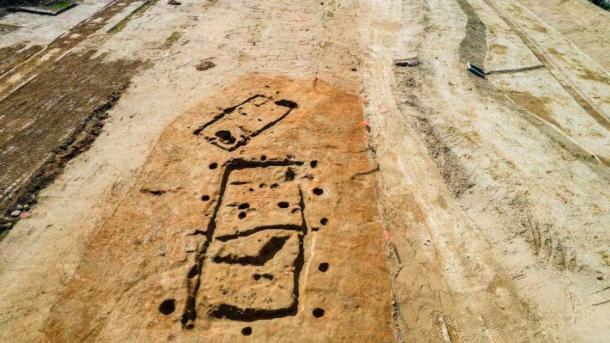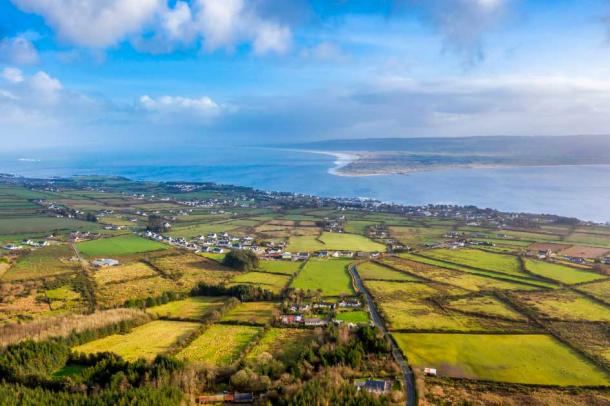
Grand Neolithic Homes Dating Back 5,800 Years Found in Northern Ireland
In the past, archaeologists exploring near the banks of Lough Foyle in Ireland have found ruins and artifacts linked to the first millennium AD Kingdom of Aileach. But evidence suggests this area was first occupied by a Neolithic culture that was constructing settlements and sacred monuments more than 5,000 years ago. A recent excavation has uncovered some of the best evidence yet proving the existence of this ancient culture and showing how they lived, in the form of ruins and multiple artifacts from two large rectangular houses that date back to 3,800 BC.
According to the BBC, the artifacts were unearthed during a 2021 dig that took place along Clooney Road just outside Londonderry, Northern Ireland, along Lough Foyle’s southern coast. The excavation that produced this exciting find was launched in anticipation of an upcoming housing project, which could have badly damaged these sensitive ruins if researchers hadn’t gotten to them first.
Future Homebuilding Project Reveals Presence of Homes from the Past
During their eventful explorations, a team led by archaeologist Kay McMonagle from the private firm Northern Archaeological Consultancy found the distinctive outlines of two Neolithic period homes that were once covered with a large peaked roof. The carved bedrock revealed the presence of dividing walls and solid foundations shaped to support oak planks. Inside the outlined areas of these ancient houses they also uncovered an impressive collection of Neolithic tools, cooking utensils and pottery.
The archaeologists note that this type of rectangular Neolithic house has been found primarily in Scotland and Ireland and is rarely discovered anywhere else.
"Around Lough Foyle specifically … it has a high density of settlement dated to the early Neolithic. That shows around Lough Foyle there were lots and lots of Neolithic people living," McMonagle said during a BBC radio interview radio interview.
Nevertheless, archaeologists have only discovered a few houses exactly like this one. Between 4,000 and 2,000 BC homes built in this part of the world were mostly circular in shape.
"They [the rectangular homes] were a short-lived phenomenon, that means it is even more exciting," McMonagle added.
- The Unique Architectural Heritage of Icelandic Turf Houses
- The Megalithic Mystery of the Greek Dragon Houses

The foundations of the rectangular Neolithic houses found on the banks of Lough Foyle. (Northern Archaeological Consultancy)
In comparison to today’s homes, these Neolithic dwellings were quite expansive. They were constructed by people who were agriculturalists and who in general lived a fully independent and self-sufficient lifestyle, so they required plenty of living and working space. People also would have lived in scattered agricultural settlements where land availability was not an issue.
"When we were digging it out you could see how amazing it would have looked, how deep the foundations were,” McMonagle said about the rectangular houses. "The soil is good there and they are in a substantial place, with Lough Foyle as a resource. It would have been a beautifully wooded area back in the Neolithic. They would have been using that landscape so well."
Exploring the Fascinating History of the Lough Foyle Region
Located on Ireland’s north coast, Lough Foyle is the estuary of the River Foyle. It provides an outlet to the North Atlantic, which is accessible for ships leaving from or arriving at ports that belong to Northern Ireland to the east and the Republic of Ireland to the west. The 1921 Partition of Ireland that split the island into two sections placed put Lough Foyle directly on the border that separates Ireland and Northern Ireland, and both Ireland and the United Kingdom have claimed ownership of the lake ever since.
The freshly excavated rectangular houses are definitively on the Northern Ireland side of the border. But 5,000 years ago there was a unified culture living in the region that didn´t recognize such macro-level divisions. At that time geographical distinctions would have been made at the settlement or community level.
- Golden Gifts to a Sea God: The Broighter Hoard and Its Mysterious Golden Boat
- Grianan of Aileach: Hillfort of a Legendary Kingdom

The Neolithic houses were found near the banks of Lough Foyle, Northern Ireland. (Lukassek / Adobe Stock)
This new discovery is not the first time evidence of Neolithic community-building activity has been unearthed along the shores of Lough Foyle. In the year 2000 an excavation in the Culmore area of Derry revealed the remains of a 6,000-year-old village. This extremely early settlement would have been home to about 50 of Ireland’s first farming families. That site contained ax heads, arrowheads and pottery in addition to the remains of various structures.
Archaeologists have long known that the area around Lough Foyle is filled with ancient historical treasures, both from ancient Neolithic settlements and the Kingdom of Aileach. So when Northern Archaeology Consultancy was hired to make exploratory digs on Clooney Road in advance of the upcoming housing development project, they were hopeful something interesting might turn up—which it obviously did.
In addition to the remnants of the impressively constructed homes, the archaeological team was also excited to discover such a diverse set of Neolithic artifacts.
Among these prizes were serrated tools that would have been used to strip bark from trees. This particular Neolithic implement is in fact unique to Ireland.
The archaeologists also found a Plano-convex knife, a two-sided and ultra-sharp type of blade known for its versatility. The latter is known from other Neolithic sites and was used for a “little bit of everything, like a Swiss Army knife,” said McMonagle. She said the knives like this were used earlier in Ireland than at just about any other place in the world.
Another interesting find was a grinding stone, which would have been used to process grain. This shows the people knew how to cultivate the land and grow significant quantities of that vitally important crop.
The Northern Archaeology Consultancy archaeologists are currently doing post-excavation work on everything they discovered during the Clooney Road dig. The team hopes to display some of what they found to the public in the near future, but in the meantime their discoveries have already been discussed on the ancient history series Digging for Britain, which airs on BBC2 and makes episodes available for streaming on their website.
Top image: Neolithic houses. Source: AI generated
By Nathan Falde















